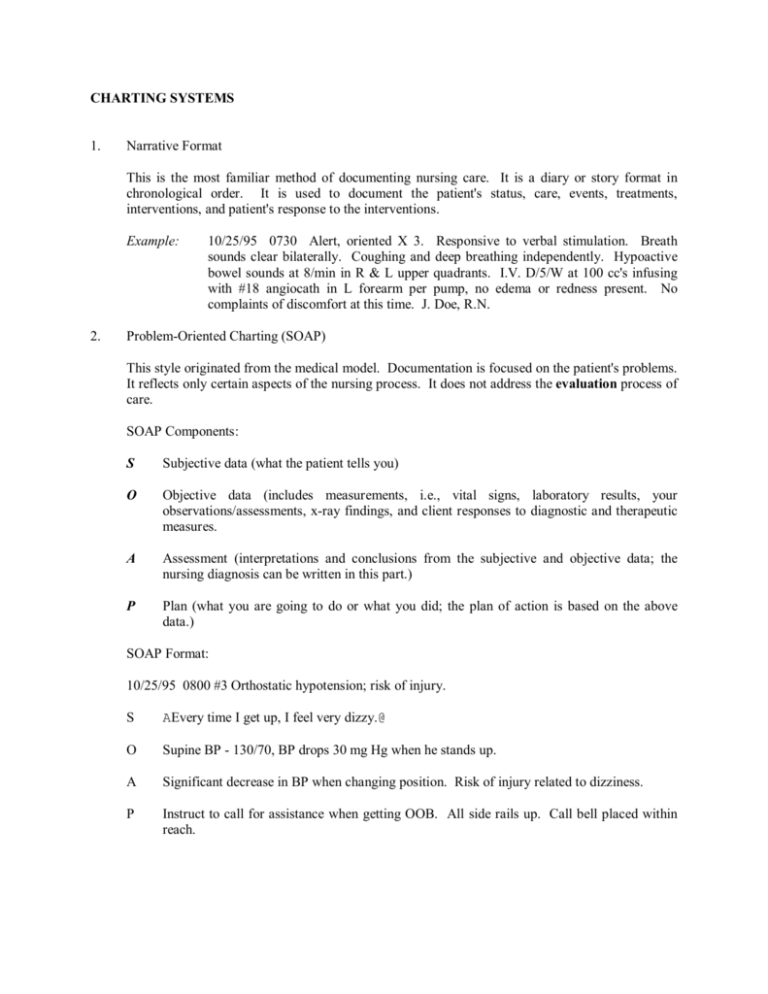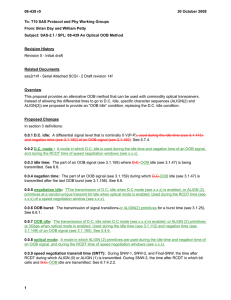CHARTING SYSTEMS 1. Narrative Format This is the most familiar
advertisement

CHARTING SYSTEMS 1. Narrative Format This is the most familiar method of documenting nursing care. It is a diary or story format in chronological order. It is used to document the patient's status, care, events, treatments, interventions, and patient's response to the interventions. Example: 2. 10/25/95 0730 Alert, oriented X 3. Responsive to verbal stimulation. Breath sounds clear bilaterally. Coughing and deep breathing independently. Hypoactive bowel sounds at 8/min in R & L upper quadrants. I.V. D/5/W at 100 cc's infusing with #18 angiocath in L forearm per pump, no edema or redness present. No complaints of discomfort at this time. J. Doe, R.N. Problem­Oriented Charting (SOAP) This style originated from the medical model. Documentation is focused on the patient's problems. It reflects only certain aspects of the nursing process. It does not address the evaluation process of care. SOAP Components: S Subjective data (what the patient tells you) O Objective data (includes measurements, i.e., vital signs, laboratory results, your observations/assessments, x­ray findings, and client responses to diagnostic and therapeutic measures. A Assessment (interpretations and conclusions from the subjective and objective data; the nursing diagnosis can be written in this part.) P Plan (what you are going to do or what you did; the plan of action is based on the above data.) SOAP Format: 10/25/95 0800 #3 Orthostatic hypotension; risk of injury. S AEvery time I get up, I feel very dizzy.@ O Supine BP ­ 130/70, BP drops 30 mg Hg when he stands up. A Significant decrease in BP when changing position. Risk of injury related to dizziness. P Instruct to call for assistance when getting OOB. All side rails up. Call bell placed within reach. 3. SOAPIE or SOAPIER This is a modified version of SOAP. It adds Implementation (I), Evaluation (E), and Revision (R). Revision or Reassessment refers to the changes that must be made in the initial or original plan. SOAPIE(R) Format: 10/25/95 0800 #3 Orthostatic hypotension; risk of injury. S, O, A: See previous example. 4. P Instruct to call for assistance when getting OOB. Place call bell within reach. Put all side rails up. Measure BP before and after changing position. I Instructed to call for assistance when getting OOB. Call bell within reach. All side rails up. E 1100 ­ always calls for assistance. States AI still get dizzy when I get up.@ R (Plan) Will continue previous plan of action. Will evaluate as indicated by symptoms. APIE Format This is also a problem­oriented charting format that arose from the nursing process. A Assessment P Problems (usually numbered: #1, #2, etc.) I Intervention E Evaluation The APIE system of charting consists of a patient care/assessment flow sheet and the progress notes. The daily assessment flow sheet is a 24­hour sheet that lists specific assessment criteria such as respirations, skin, routine care, activities, etc. Criteria deviating from the normal are marked with an asterisk (*). The nurse must provide a description of these in the progress (nurse's) notes. APIE Format: 10/25/95 0800 A #1 ­ Supine BP 130/70. BP drops 20­30 mg Hg when he stands up. P #1 ­ Risk of injury related to dizziness. I #1 ­ Instructed to call for assistance when getting OOB. All side rails up. Call bell placed within reach. E #1 ­ Consistently calls for assistance. Still experiencing dizziness and orthostatic BP changes. 5. Focus Format This is not limited to clinical problems. It may include a client's concern or behavior, e.g., anxiety; a change in status or behavior, e.g., seizures, combative; an event in the client's therapy, e.g., surgery, chemotherapy; signs/symptoms, e.g., fever, nausea; nursing diagnosis, e.g., risk of infection. Key Elements: D Subjective and/or objective data that support data A Action, nursing interventions R Client's response to the interventions Example of Focus Format: Focus charting uses three columns in the nurse's notes. DATE/TIME FOCUS NOTES 10/25/95 0800 Dizziness D: Complaining of dizziness when getting OOB. Supine BP 130/70. A: Instructed to call for assist­ ance when getting OOB. All side rails up. Call bell within reach. R: Still experiencing dizziness and orthostatic BP changes. 6. Charting by Exception (CBE) With this documentation system, only significant findings or Aexceptions@ to the norms are recorded. Three Key Components: 1. Use of nursing flow sheets, physician order flow sheets, graphic records, client teaching records, and the patient's discharge notes. 2. Documentation by reference to standards of nursing practice. 3. Bedside accessibility of documentation forms. All flow sheets are kept at the client's bedside. CBE uses a specific set of abbreviations. These are: T The assessment was completed and no abnormal findings were noted. * Significant abnormal findings are present and are described in the bottom section of the flow sheet. 6 The client's status remains unchanged since the previous entry identified with an *.







